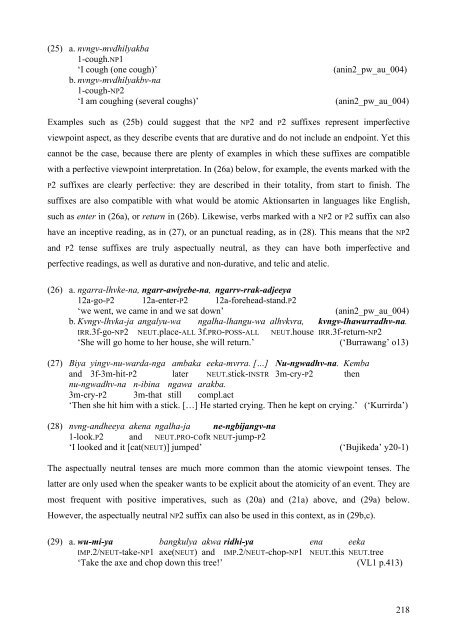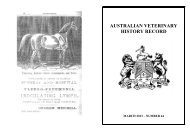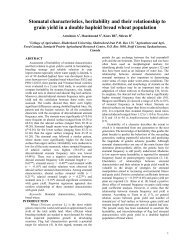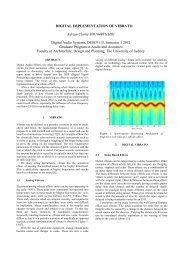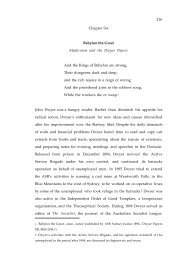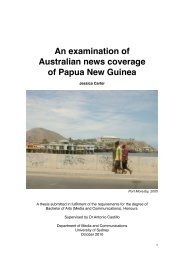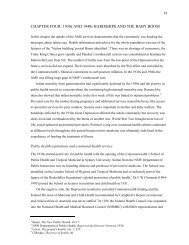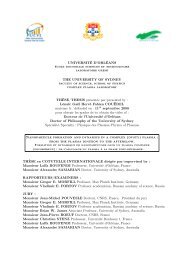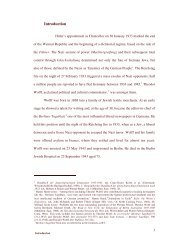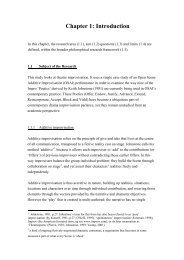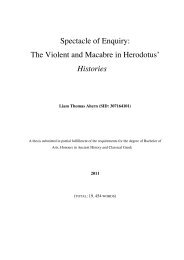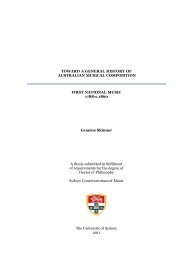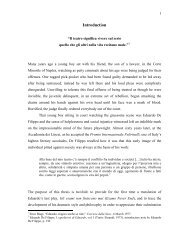Chapter 6: Tense, aspect and mood
Chapter 6: Tense, aspect and mood
Chapter 6: Tense, aspect and mood
Create successful ePaper yourself
Turn your PDF publications into a flip-book with our unique Google optimized e-Paper software.
(25) a. nvngv-mvdhilyakba<br />
1-cough.NP1<br />
‘I cough (one cough)’ (anin2_pw_au_004)<br />
b. nvngv-mvdhilyakbv-na<br />
1-cough-NP2<br />
‘I am coughing (several coughs)’ (anin2_pw_au_004)<br />
Examples such as (25b) could suggest that the NP2 <strong>and</strong> P2 suffixes represent imperfective<br />
viewpoint <strong>aspect</strong>, as they describe events that are durative <strong>and</strong> do not include an endpoint. Yet this<br />
cannot be the case, because there are plenty of examples in which these suffixes are compatible<br />
with a perfective viewpoint interpretation. In (26a) below, for example, the events marked with the<br />
P2 suffixes are clearly perfective: they are described in their totality, from start to finish. The<br />
suffixes are also compatible with what would be atomic Aktionsarten in languages like English,<br />
such as enter in (26a), or return in (26b). Likewise, verbs marked with a NP2 or P2 suffix can also<br />
have an inceptive reading, as in (27), or an punctual reading, as in (28). This means that the NP2<br />
<strong>and</strong> P2 tense suffixes are truly <strong>aspect</strong>ually neutral, as they can have both imperfective <strong>and</strong><br />
perfective readings, as well as durative <strong>and</strong> non-durative, <strong>and</strong> telic <strong>and</strong> atelic.<br />
(26) a. ngarra-lhvke-na, ngarr-awiyebe-na, ngarrv-rrak-adjeeya<br />
12a-go-P2 12a-enter-P2 12a-forehead-st<strong>and</strong>.P2<br />
‘we went, we came in <strong>and</strong> we sat down’ (anin2_pw_au_004)<br />
b. Kvngv-lhvka-ja angalyu-wa ngalha-lhangu-wa alhvkvra, kvngv-lhawurradhv-na.<br />
IRR.3f-go-NP2 NEUT.place-ALL 3f.PRO-POSS-ALL NEUT.house IRR.3f-return-NP2<br />
‘She will go home to her house, she will return.’ (‘Burrawang’ o13)<br />
(27) Biya yingv-nu-warda-nga ambaka eeka-mvrra. […] Nu-ngwadhv-na. Kemba<br />
<strong>and</strong> 3f-3m-hit-P2 later NEUT.stick-INSTR 3m-cry-P2 then<br />
nu-ngwadhv-na n-ibina ngawa arakba.<br />
3m-cry-P2 3m-that still compl.act<br />
‘Then she hit him with a stick. […] He started crying. Then he kept on crying.’ (‘Kurrirda’)<br />
(28) nvng-<strong>and</strong>heeya akena ngalha-ja ne-ngbijangv-na<br />
1-look.P2 <strong>and</strong> NEUT.PRO-CofR NEUT-jump-P2<br />
‘I looked <strong>and</strong> it [cat(NEUT)] jumped’ (‘Bujikeda’ y20-1)<br />
The <strong>aspect</strong>ually neutral tenses are much more common than the atomic viewpoint tenses. The<br />
latter are only used when the speaker wants to be explicit about the atomicity of an event. They are<br />
most frequent with positive imperatives, such as (20a) <strong>and</strong> (21a) above, <strong>and</strong> (29a) below.<br />
However, the <strong>aspect</strong>ually neutral NP2 suffix can also be used in this context, as in (29b,c).<br />
(29) a. wu-mi-ya bangkulya akwa ridhi-ya ena eeka<br />
IMP.2/NEUT-take-NP1 axe(NEUT) <strong>and</strong> IMP.2/NEUT-chop-NP1 NEUT.this NEUT.tree<br />
‘Take the axe <strong>and</strong> chop down this tree!’ (VL1 p.413)<br />
218


